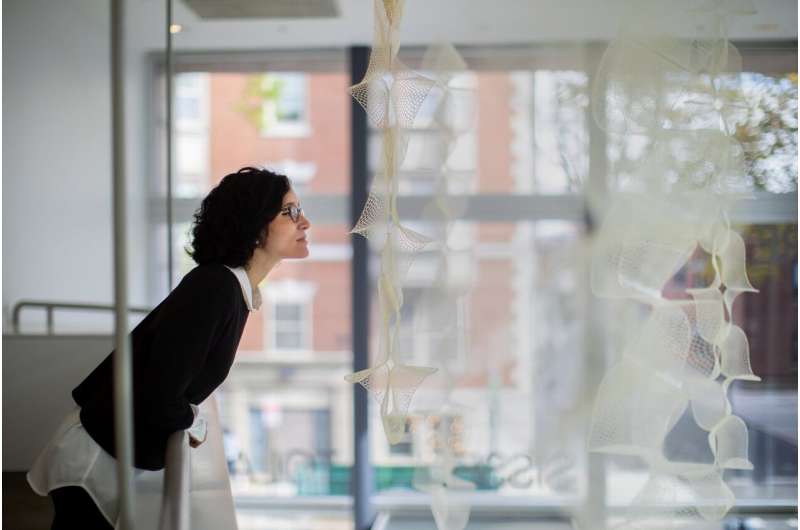This article has been reviewed according to Science X's editorial process and policies. Editors have highlighted the following attributes while ensuring the content's credibility:
fact-checked
trusted source
proofread
Antimicrobial, air-clearing qualities of architectural biomaterials

Can building materials make indoor air healthier?
That was the question behind the elegant, aromatic lattices that hung from the lobby ceiling at the Institute of Contemporary Art during the 2022 ACADIA conference, which was hosted by Weitzman's Department of Architecture last fall. Not an art installation themselves, the lattices represent early progress in an ongoing research project on the antimicrobial, air-clearing qualities of architectural biomaterials.
The project, Senseable Biomaterials for Healthier Habitats, or SENSBIOM, is led by Assistant Professor of Architecture Laia Mogas-Soldevila, the director of the DumoLab at Weitzman, Vlasta Kubušová, crafting plastics! director and Fulbright Fellow at DumoLab, along with the support of Katia Zolovsky of the Rhode Island School of Design, Andreas Mershin of the MIT Media Lab, and a team of undergraduate and graduate students at Penn. The long-term focus of the project is whether and how building materials can be used to "passively identify threats in indoor air and correct their toxicity with aroma-active molecule release," according to a project description.
Fabricated both by DumoLab and by crafting plastics! in Slovakia, most of the 3D-printed lattices are made from commercial bioplastics that are industrially compostable, and an experimental subset is made naturally biodegradable from chitin and cellulose, some of "the most abundant biopolymers on earth," and strengthened with silk.
The lattices were designed to maximize surface area and porosity, which would soon allow them to act as passive air filters. And they were infused with the molecule zingerone, an aroma that's sometimes used in perfumes, and which once was linked to anti-pest properties. Mogas-Soldevila, who joined the Weitzman faculty in 2021, describes zingerone as having "an earthy, forest-y smell." The installation overlapped with the exhibition at the ICA, a collection of scent-themed works by the artist Sissel Tolaas, which was on display in late 2022.
"We were excited that it was a pleasant smell, had been historically mapped to human health, and could contribute to air quality," Mogas-Soldevila says.
How powerful are these materials for detoxifying air? Could they be used to sense and correct volatile compounds in the air, or even to neutralize harmful aromas? That's the subject of the ongoing SENSBIOM research. The lattices were devised as a proof of concept—something that could be used to test the capabilities of the materials. But the team has envisioned broader applications of the materials, including indoor partitions or panels that could passively clean air in buildings with poor air quality or in polluted areas.
"Biology takes years," Mogas-Soldevila says. So, to push the project forward, the group is setting itself deadlines. The next step is to verify the impact of the objects on indoor air, and publish the findings. In the spring, the group hopes to present a prototype of the partition in a public venue. In a year, she says, "we want to have a system that we are happy about."
For Mogas-Soldevila, whose research focuses on how biomaterials can help architecture respond to demands for greater sustainability and efficiency, the SENSBIOM project is an exercise in collaboration, and in putting an idea to the test.
"There's so many options: so many different biological pathways you have to choose from, so many different aromas, so many different trapping mechanisms," she says. "When do we stop and say, This is good enough? Because architecture is always unfinished, it's never perfect."
Provided by University of Pennsylvania




















